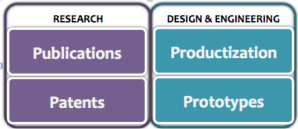
Women In Business Markham Event at IBM Canada Software Lab, 8200 Warden Markham site, December 3rd 2014.
#WomenInBusinessMKM
I capture my Lightning Talk at the Markham December 3rd, 2014 event of Women Cultivating Innovation for Business Success in this blog entry.
Henry Ford once said, “Innovation without execution is hallucination.”
I confess that I can’t stop “hallucinating” in that sense all day long. When I first took on this job as the Head of Research for CAS, IBM Canada Software Lab, my calendar was filled with back to back meetings. I met with many distinguished academics, researchers and technologists. We talked about innovations in various technology areas. Many brain storming ideas had great potential. I was greatly energized with my head filled with innovative ideas that had I switched my schedule to a twenty four hours work day, it wouldn’t have been enough to process them all.
How can great ideas in people’s heads be transposed into external reality that leads to business success?
The key to execute innovative ideas into business success is CLARITY.
I highlight in particular the clarity in definition of success and the clarity in definition of relationships within the innovation Eco-system. The benefits are priceless. Such clarity:
- Establishes shared goals
- Establishes common understanding of roles and rules of engagement
- Provides path for participation
- Motivates contributions
from all parties within the innovation Eco-system.
Clarity in Definition of Success

Academics and researchers value citations of publications. But to the bottom line of IBM’s software business, publications, while important, by itself alone is not enough to justify the return on research investment. We cannot possibly rest just by publishing how to make cars academically while people are traveling by horses, until people are actually given cars to drive. Innovation has to hit home run by bringing positive transformations in real life.
On the other hand, products built without harvesting research outcome may not be as solidly grounded on validated assumptions, with proven technology established through methodical approaches.
Leading an organization of applied research for commercialization, we clearly define success as measured in the four-P languages of innovation namely, by patents, publications, prototypes and productization.
Clarity in Definition of Relationship
There are many parties and many people we work with within the Eco system of innovation. Clearly defining the relationship is key to a productive and mutually beneficial partnership. Examples of Key relationships in my world of technology innovation include (but not limited to):
- Research Partners:
- Are they partners from whom I consume their research outcome?
- Are they partners whom I share my research agenda with as an invitation to new research areas?
- Are they partners as co-innovator?
- Customers
- Are they sources of problem statements validation?
- Are they early adopters of technology in proof of architecture, to provide feedback?
- Are they purchasers of our technology?
- Industrial partners
- Are they competitors?
- Are they collaborators?
- Are they co-researhcers and/or co-innovators?
- Business investors
- Are they funding sources (e.g. venture capitalists)?
- Are they business partners to take the technology to market (e.g. marketing and sales etc..)
- Public communities
- Are they advocates and influence-rs?
- Are they crowd-sourcing? validating?
One partner can be in multiple relationships or change relationship from one type to another at different point in time.
Clarity in definition of success and definition of relationship accelerates efficiency and provides focus in innovation execution, greatly facilitating the transposing of great ideas internal to people’s heads into external transformed reality that brings positive impact and benefits.








